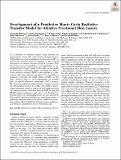Files in this item
Development of a predictive Monte Carlo radiative transfer model for ablative fractional skin lasers
Item metadata
| dc.contributor.author | McMillan, Lewis | |
| dc.contributor.author | O'Mahoney, Paul | |
| dc.contributor.author | Feng, Kairui | |
| dc.contributor.author | Zhou, Kanheng | |
| dc.contributor.author | Barnard, Isla Rose Mary | |
| dc.contributor.author | Li, Chunhui | |
| dc.contributor.author | Ibbotson, Sally | |
| dc.contributor.author | Eadie, Ewan | |
| dc.contributor.author | Brown, C Tom A | |
| dc.contributor.author | Wood, Kenny | |
| dc.date.accessioned | 2020-11-09T09:30:02Z | |
| dc.date.available | 2020-11-09T09:30:02Z | |
| dc.date.issued | 2021-07 | |
| dc.identifier | 270577723 | |
| dc.identifier | 0d75e1c7-429a-4ca7-a1fe-32eaecfa4b6a | |
| dc.identifier | 000587152600001 | |
| dc.identifier | 85096742384 | |
| dc.identifier.citation | McMillan , L , O'Mahoney , P , Feng , K , Zhou , K , Barnard , I R M , Li , C , Ibbotson , S , Eadie , E , Brown , C T A & Wood , K 2021 , ' Development of a predictive Monte Carlo radiative transfer model for ablative fractional skin lasers ' , Lasers in Surgery and Medicine , vol. 53 , no. 5 , pp. 731-740 . https://doi.org/10.1002/lsm.23335 | en |
| dc.identifier.issn | 0196-8092 | |
| dc.identifier.other | ORCID: /0000-0002-7725-5162/work/83481921 | |
| dc.identifier.other | ORCID: /0000-0002-4405-6677/work/86537139 | |
| dc.identifier.uri | https://hdl.handle.net/10023/20928 | |
| dc.description | L.M. would like to acknowledge the funding from EPSRC grant code: EP/K503162/1. P.O'M. is funded by Medi‐Lase (registered charity SC 037390) and the Alfred Stewart Trust'. | en |
| dc.description.abstract | It is possible to enhance topical drug delivery by pretreatment of the skin with ablative fractional lasers (AFLs). However, the parameters to use for a given AFL to achieve the desired depth of ablation or the desired therapeutic or cosmetic outcome are hard to predict. This leaves open the real possibility of overapplication or underapplication of laser energy to the skin. In this study, we developed a numerical model consisting of a Monte Carlo radiative transfer (MCRT) code coupled to a heat transfer and tissue damage algorithm. The simulation is designed to predict the depth effects of AFL on the skin, verified with in vitro experiments in porcine skin via optical coherence tomography (OCT) imaging. Ex vivo porcine skin is irradiated with increasing energies (50–400 mJ/pixel) from a CO2 AFL. The depth of microscopic treatment zones is measured and compared with our numerical model. The data from the OCT images and MCRT model complement each other well. Nonablative thermal effects on surrounding tissue are also discussed. This model, therefore, provides an initial step toward a predictive determination of the effects of AFL on the skin. | |
| dc.format.extent | 10 | |
| dc.format.extent | 907814 | |
| dc.language.iso | eng | |
| dc.relation.ispartof | Lasers in Surgery and Medicine | en |
| dc.subject | Ablation | en |
| dc.subject | Aesthetics | en |
| dc.subject | Monte Carlo | en |
| dc.subject | Predictive | en |
| dc.subject | QC Physics | en |
| dc.subject | RC Internal medicine | en |
| dc.subject | DAS | en |
| dc.subject.lcc | QC | en |
| dc.subject.lcc | RC | en |
| dc.title | Development of a predictive Monte Carlo radiative transfer model for ablative fractional skin lasers | en |
| dc.type | Journal article | en |
| dc.contributor.institution | University of St Andrews. Centre for Biophotonics | en |
| dc.contributor.institution | University of St Andrews. School of Physics and Astronomy | en |
| dc.contributor.institution | University of St Andrews. Office of the Principal | en |
| dc.identifier.doi | 10.1002/lsm.23335 | |
| dc.description.status | Peer reviewed | en |
This item appears in the following Collection(s)
Items in the St Andrews Research Repository are protected by copyright, with all rights reserved, unless otherwise indicated.

